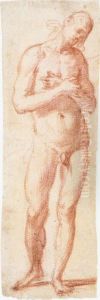Lorenzo Ii Costa Paintings
Lorenzo Costa the Younger was an Italian painter of the Renaissance period, active mainly in his hometown of Mantua. He was born in 1537, the son of another prominent painter, Ippolito Costa, and the grandson of Lorenzo Costa the Elder, who was a well-known artist in his own right, having been part of the Ferrarese school and later working in Bologna and Mantua. This artistic lineage provided the younger Costa with a rich environment for learning and developing his own artistic skills.
Costa inherited the artistic tradition of the family and was influenced considerably by his grandfather's style, which was characterized by a blend of Ferrarese and Bolognese elements. He worked under the patronage of the Gonzaga family in Mantua, which was one of the leading centers of art and culture during the Renaissance. His works often included religious subjects and followed the Mannerist style, which was popular at the time and emphasized artificiality and the use of unusual effects of scale and perspective.
Despite the shadow cast by his illustrious grandfather, Lorenzo Costa the Younger managed to establish his own reputation as a painter. He painted a number of altarpieces and frescoes for churches and also contributed to the decoration of the Ducal Palace in Mantua. His style is noted for its elegance and a certain courtly grace, which aligned well with the tastes of his noble patrons.
Lorenzo Costa the Younger's career was relatively short, as he died at a young age of 46 in 1583. His works remain as a testament to the continuation of the Costa family's artistic legacy and provide insight into the transition from High Renaissance art to the Mannerist style that dominated the late 16th century in Italy. Although not as widely recognized today as his grandfather or some of his contemporaries, Costa's contributions to the art of the Renaissance period remain significant and can be seen in various churches and museums, particularly in Mantua.
